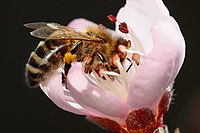
Photo from wikipedia
Abstract In some horticultural crops, such as Cucurbitaceae, Solanaceae, and Rosaceae species, fruit set and development can occur without the fertilization of ovules, a process known as parthenocarpy. Parthenocarpy is… Click to show full abstract
Abstract In some horticultural crops, such as Cucurbitaceae, Solanaceae, and Rosaceae species, fruit set and development can occur without the fertilization of ovules, a process known as parthenocarpy. Parthenocarpy is an important agricultural trait that can not only mitigate fruit yield losses caused by environmental stresses but can also induce the development of seedless fruit, which is a desirable trait for consumers. In the present review, the induction of parthenocarpic fruit by the application of hormones such as auxins (2,4 dichlorophenoxyacetic acid; naphthaleneacetic acid), cytokinins (forchlorfenuron; 6-benzylaminopurine), gibberellic acids, and brassinosteroids is first presented. Then, the molecular mechanisms of parthenocarpic fruit formation, mainly related to plant hormones, are presented. Auxins, gibberellic acids, and cytokinins are categorized as primary players in initiating fruit set. Other hormones, such as ethylene, brassinosteroids, and melatonin, also participate in parthenocarpic fruit formation. Additionally, synergistic and antagonistic crosstalk between these hormones is crucial for deciding the fate of fruit set. Finally, we highlight knowledge gaps and suggest future directions of research on parthenocarpic fruit formation in horticultural crops.
Journal Title: Horticulture Research
Year Published: 2022
Link to full text (if available)
Share on Social Media: Sign Up to like & get
recommendations!